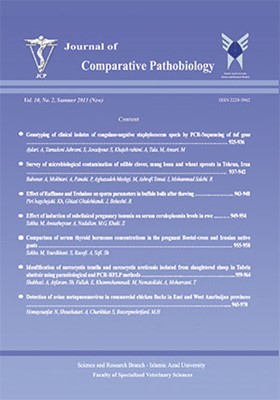Inhibition of inflammatory pain induced by formalin test by quercetin: role of opioidergic, nitric oxide and histaminergic pathways in mice
Subject Areas : Journal of Comparative Pathobiology
SH Hassanpour
1
![]() ,
S Zahedi
2
,
AH Sarfi
3
,
S Zahedi
2
,
AH Sarfi
3
1 - Division of Physiology, Department of Basic Sciences, Faculty of Veterinary Medicine, Science and Research Branch, Islamic Azad University, Tehran, Iran
2 - Student of Veterinary Medicine, Science and Research Branch, Islamic Azad University, Tehran, Iran
3 - Student of Veterinary Medicine, Science and Research Branch, Islamic Azad University, Tehran, Iran
Keywords: Quercetin, Inflammatory pain, Mouse,
Abstract :
The present study was conducted in order to investigate the role of opioidergic, nitric oxide and histaminergic pathways in pain inhibition by quercetin in mice. 85 male mice were randomly evaluated in 5 experimental phases with four groups and 5 repetitions in each group. In experiment 1, in order to investigate the analgesic effects of quercetin, the first group as a control, the second to fourth groups received levels of 50, 100 and 150 mg/kg of quercetin, respectively, and the fifth group received morphine (5 mg/kg). After determining the effective level of quercetin, the experiments of the second to fourth stages were designed and implemented. In the second experiment, experimental groups included control, injection of quercetin (150 mg/kg), naloxone (non-selective antagonist of opioid receptors, 2 mg/kg) and combined administration of quercetin (150 mg/kg) with naloxone (2 mg/kg). In third and fourth experiments, L-NAME (nitric oxide synthesis inhibitor, 10 mg/kg) and cyproheptadine (non-selective antagonist of histamine receptors, 4 mg/kg) were used instead of naloxone. Then the formalin test was performed by injecting it into the sole of the right foot and the duration of pain (time of licking and biting the injected foot) was measured in time periods of 0-5 minutes (first phase) and 15-30 minutes (second phase). According to the results, injection of different levels of quercetin significantly reduced pain time (P<0.05). Co-injection of naloxone or L-NAME plus quercetin significantly reduced the analgesic effects of quercetin (P<0.05). The results showed that quercetin has analgesic properties and this effect is mediated through the nitrergic and opioidergic pathways in mice.
_||_

